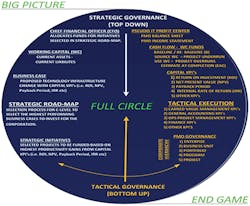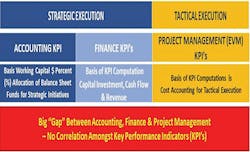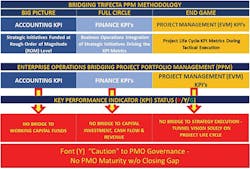Divorced Bed KPI Metrics
How Effective Project Portfolio Management (PPM) Can Deliver Shareholder Value —
Managed Service Providers (MSPs) in Telecom are focused on customers’ needs. They are also focused on delivering shareholder value — which is divorced in most Project Portfolio Management (PPM) tools. To meet the first objective of the digital transformation, they must deploy, maintain, and secure, the networks they provide. In order to meet the second objective, they must increase revenue by reducing costs.
Project Management Professionals (PMPs) and Project Management Governance (PMG) are part of that equation. Therefore, leaders in the PPM discipline must hire PMPs who can successfully help telcos transform their wireline and wireless networks while managing working capital investments by controlling costs in an effective and efficient manner in a reliable, scale-able, and sustainable PPM tool.
To do that, leaders of the Project Management Offices (PMOs) seek recruits who have various certifications to complement their respective in-house PPM tools to reduce the learning curve once they are hired for data input and report design.
After those folks are hired, expectations are that the PMO Governance will run like a well-oiled machine and deliver in both areas of stakeholder success and shareholder value.
Unfortunately, it doesn’t work — not even 50% of the time. Not only do PMPs struggle to fulfill their mission. But the dissolution of PMO Governance is astonishing. Published studies show 50% of PMOs are shuttered within the first three years of existence. Also, PMOs have the highest failure rate of any department in the business organization. That doesn’t fare well for PMPs. Nor does it help telecom providers deliver to their shareholders.
InvisiLight® Solution for Deploying Fiber
April 2, 2022Go to Market Faster. Speed up Network Deployment
April 2, 2022Episode 10: Fiber Optic Closure Specs Explained…
April 1, 2022Food for Thought from Our 2022 ICT Visionaries
April 1, 2022The Business Operating Machine Doesn’t Stop
Still, stakeholders’ needs must be met. And networks must be deployed and maintained — all while keeping up with automation, network functionalization virtualization, and cybersecurity. That means CapEx and PMO Governance are required to implement projects according to the project baseline for delivery on time within budget.
Without a high-functioning PMO, C-Level Executives may instead outsource/subcontract future projects to consulting firms with high billing rates. If so, I wonder whether that trade-off provides a true value proposition, or is it a knee-jerk management restructuring move to attempt to fix the problem?
Other companies may allow PMOs to survive. This is because C-Level Executives understand that PMOs help consolidate and summarize reports for large working capital investments to the CEO and Board of Directors. And this helps the company achieve its business objectives — if it is done correctly.
Don’t Kill the Project Messenger
As a PMP, you may not like this message. You may also question why hiring teams think more certifications and acronyms after your name are the answer.
As an instructor with several certifications (GE FMP, PMP, Lean Six Sigma Green and Black Belt), I see a plethora of information (via textbooks) that is provided at a costly price yet doesn’t help you, the candidate, learn how to apply your discipline in the real world. I also see a vast number of certification programs and acronyms (PMP, PgMP, PfMP, Scrum, Agile, etc.) that are available to technology candidates.
Given the dismal 40% success rate of project management success rates, I might argue that textbook knowledge alone may be an exercise in futility. Instead, what is needed is 1.) strong certification and 2.) a complementary analytics program PMs can use to help telcos deliver for their stakeholders, customers, AND their shareholders. These 2 things will help PMPs succeed regardless of the in-house PPM tool they inherit when they are hired upon completion of proper training.
Think about it. This would create a win-win scenario as opposed to dissolution of PMO Governance at a rate of 50%.
There’s Got to Be a Better Way
To begin, let’s get clear on the basics. Please take a moment to read the sidebar What in the Heck is PPM? You need that to digest the concept of a PPM tool and how it can help both you and your employer.
[toggle title=”What in the heck is PPM?” load=”hide”]Project Portfolio Management (PPM) Definition
Project Portfolio Management (PPM) is the centralized management of the processes, methods, and technologies, used by Project Managers and Project Management Offices (PMOs) to analyze and collectively manage current or proposed projects based on numerous key characteristics.
The objectives of PPM are to determine the optimal resource mix for delivery and to schedule activities to best achieve an organization’s operational and financial goals — while honoring constraints imposed by customers, strategic objectives, or external real-world factors.
Portfolio management ensures that an organization can leverage its project selection and execution success. It refers to the centralized management of one or more project portfolios to achieve strategic objectives. Research has shown that portfolio management is a way to bridge the gap between strategy and implementation. PPM is about more than running multiple projects.
Each portfolio of projects needs to be assessed on its business value and adherence to business strategy. The portfolio should be designed to achieve a defined business objective or benefit. Project management authority Bob Buttrick summarized it when he said: "Directing the individual project correctly will ensure it is done right. Directing ‘all the projects’ successfully will ensure we are doing the right projects."
PPM must be perceived as a business-critical process for organizations that have the intention to grow, accelerate. and improve. Those organizations who want to be an outlier and exception in their marketplace put serious effort into implementing and deploying a robust PPM solution. It is part of innovation and getting better than your competition. [/toggle]
Sources say the major contributor to the dissolution of PMOs within the first 3 years is not identifying the real benefits from information technology projects. This is due to a lack of understanding about the financial impact that can result from sunsetting legacy applications as well as the current costs of older applications. Other benefits include the soft and hard dollar savings resulting from implementing new, more effective applications.
In a more perfect world, a strategic view would complement a tactical approach to help PMOs succeed. Together, those 2 views would be used to uncover the financial benefits of proposed information technology projects, and those analytics would be easily communicated to C-Level Executives. Using a full-circle approach, PMO Governance could then close the information gap by tracking categoric current state costs compared to future state costs. This would reveal hard financial evidence about the potential success or failure of a future project.
How can that be accomplished? By performing a detailed review of each general accounting category that is impacted (+/-) such: SaaS, software procurement, licensing, training, hardware and software capitalization, hardware and software expense, break fix maintenance, help desk support, etc.
This requires a view of both the forest and the trees. C-Level Executives must determine which Strategic Initiatives will yield the best performance for the organization. This is commonly referred to as the Big Picture. To do this, a business case is prepared that demonstrates the value proposition in terms of key financial performance indicators (e.g., return on investment, payback period, etc.). (See Figure 1.)
Figure 1. Trifecta PPM Methodology
Once accepted, the initiative becomes part of the company’s strategic roadmap and working capital funds are allocated. At that point, a different and more tactical view is necessary. Figure 2 shows how Tactical Governance and Strategic Governance work together. Both views help all stakeholders see the big picture and true financial benefits of the IT project.
The end game is to automate and integrate cross-functional disciplines that generate KPI metrics. Those help to analytically close the gap of silo mentality and tunnel vision. Objective and financial data helps everyone understand the value proposition of thinking holistically to achieve business objectives in a real-time manner. (See Figure 2.)
Figure 2A. Strategic Governance vs. Tactical Governance GAPs: Accounting, Finance & Project, Portfolio Management (PPM)
Figure 2B. Strategic Governance vs. Tactical Governance GAPs: Accounting, Finance & Project, Portfolio Management (PPM)
PMOs Can Create Shareholder Value
When I read that PMOs are dissolved at a faster rate than any other discipline in corporations, I get perturbed. I believe textbook training is just a foundation to pass a certification exam (i.e., PMP, PgMP, PfMP, Agile, Lean Six Sigma, etc.). In the CIO Index — Project Portfolio Management (PPM) there was no mention of required certifications. That article, and other best practices, show a centralized process would better meet both project management professionals’ AND corporate objectives.
The fact the universities, colleges, and training companies, are still training from textbooks (in some cases with costly fees) in the digital age has prompted me to bridge analytics training with textbook training. That should be supplemented with a PPM Tool designed and developed by PMO Practitioners — not by developers being instructed to build a band-aid for a pain point the PMO Governance may be experiencing at the current time. A PPM Tool should achieve approximately 85% to 90% of PMO Governance business requirements.
The dismal metrics related to the PPM discipline are embarrassing. What is truly needed is Project Managers who can apply critical thinking and analyze financial KPIs across their organization tracked and monitored by different cross-functional disciplines for a PPM Health Check. One tool that could help is Trifecta PPM Methodology.
Trifecta PPM Methodology
Its 3 primary benefits are:
PRIMARY BENEFIT #1. Chief Portfolio Officer (CPO) automated and integrated Organization Hierarchy capable of rolling up and drilling down of KPI metrics to determine root causes.
PRIMARY BENEFIT #2. Scoring KPI Metrics (0-10) and Color Coding (R/Y/G/B) automated and integrated throughout the Chief Portfolio Officer Organization Hierarchy.
PRIMARY BENEFIT #3. Cross-functional disciplines automated and integrated throughout the CPO Hierarchy bridging KPI metrics for Strategic Governance to Tactical Governance.
Undoubtedly, the telecom industry will benefit from PMs possessing the right knowledge and tools. Only then will both the stakeholders’ needs be met and the shareholders’ profits be realized.
Resources and Notes
1. Why do so many PMOs fail? It’s all about value, https://www.changepoint.com/blog/posts/turning-around-failing-pmo
2. 45 STATS YOU CAN’T IGNORE, https://www.workamajig.com/blog/project-management-statistics
3. 40 REASONS WHY PMOs FAIL. https://projectriskcoach.com/40-reasons-pmos-fail/
4. HBR – WHY YOUR IT PROJECT MAY BE RISKIER THAN YOU THINK, https://hbr.org/2011/09/why-your-it-project-may-be-riskier-than-you-think
5. HBR – HOW TO DEMONSTRATE YOUR STRATEGIC THINKING SKILLS, https://hbr.org/2019/09/how-to-demonstrate-your-strategic-thinking-skills
6. CIO – TOP PROJECT MANAGER CERTIFICATIONS:, https://www.cio.com/article/3210765/top-project-management-certifications.html
7. GARTNER MAGIC QUADRANT, https://en.wikipedia.org/wiki/Magic_Quadrant#Criticism
8. CIO Index: PROJECT PORTFOLIO MANAGEMENT (PPM) DEFINITION, https://cio-wiki.org/wiki/Project_Portfolio_Management_(PPM)
9. KEY PERFORMANCE INDICATORS (KPI’s) DEFINITION, https://en.wikipedia.org/wiki/Performance_indicator
10. BALANCE SCORECARD DEFINITION, https://en.wikipedia.org/wiki/Balanced_scorecard
11. ANALYTICS DEFINITION, https://en.wikipedia.org/wiki/Analytics#:~:text=Analytics%20is%20the%20systematic%20computational,patterns%20towards%20effective%20decision%20making
12. ENTERPRISE MODELLING, https://en.wikipedia.org/wiki/Enterprise_modelling
13. WHY PMOs FAIL, https://www.itweb.co.za/content/zKWEBbvy6Y57mRjO
14. 25 ASTOUNDING PROJECT MANAGEMENT STATISTICS [2020 UPDATE], https://goremotely.net/blog/project-management-statistics/
15. 100+ PROJECT MANAGEMENT STATISTICS & FACTS [2020 UPDATE], https://www.proprofs.com/c/project/project-management-statistics-facts-trends/
For more information, email [email protected] and visit https://aplusppm2.com. Follow on Twitter @PM_Dashboard.
Like this Article?
Subscribe to ISE magazine and start receiving your FREE monthly copy today!
About the Author








